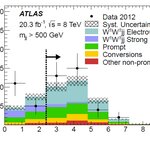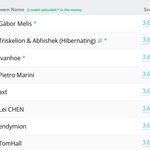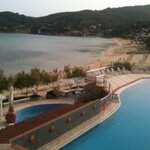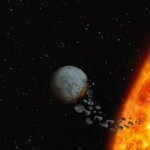Physics

Observations with the 1.6-meter telescope at Big Bear Solar Observatory (BBSO) in California, the most powerful ground-based instrument dedicated to studying the Sun, have resulted in the highest- resolution solar observations ever made.
The researchers reported on the emergence of buoyant "small-scale" magnetic-flux ropes on the solar surface and the initiation of powerful plasma eruptions in the solar atmosphere. The observations were performed as part of a program conducted jointly with NASA's Interface Region Imaging Spectrograph (IRIS) mission, Solar Dynamics Observatory (SDO) and Hinode…

They key issues in the discussion of the BICEP2 result center around the way BICEP2 accounted for dust in the foreground. They based their analysis on a presentation graphic which was shown at the April APS conference of 2013. This may have been a mistake. In the defense of the BICEP2 team, that graphic was the best data available at the time. A .fits file of this particular data from PLANCK did not exist yet. Never the less, it leads to reasonable questions about the validity of the result. When I asked the B-mode question at the April APS conference in 2013 the…

"After the 1974 London Conference, with its strong confirmation of the quark model, a general change of view developed with regard to the structure of hadrons. [...] the quark structure of hadrons became the dominant view for developing theory and planning experiments. A crucial element of this change was the general acceptance of QCD, which eliminated the last paradox, namely, why are there no free quarks ? The conjectured infrared slavery mechanism of QCD provided a reason to accept quarks as physical constituents without demanding the existence of free quarks. The asymptotic freedom…

One of the nice details lost in the big picture of the Higgs boson discovery of 2012 is that a significant part of the signal put in evidence by ATLAS and CMS is produced by a very special kind of interactions between the protons accelerated by the LHC. These are "vector boson fusion" processes, whereby it is not the protons or its constituents that come in direct contact, but rather, each proton emits a W boson, and it is the latter pair which fuse together, give rise to a Higgs particle.
You realize that such is a quite extraordinary concept. You should picture two cars launched one against…

I reported here a few days ago about a very nice challenge issued by the ATLAS experiment: find Higgs boson decays to tau lepton pairs in a sample containing signal as well as background events, using a training sample with correct signal and background labels per each event.
The challenge consists of solving a typical classification problem in a highly multidimensional space (30 dimensions) better than all other participants - the metric to judge being an "approximate median significance" of the subset of events that the user classifies as "signal". This is given by the formula
AMS = sqrt {2…

I am spending the week in the pleasant resort of La Biodola, in the Elba island. Elba is a beautiful island just off the coast of Tuscany. Here Napoleon was exiled after his abdication in 1814 (he arrived here on May 30th). Exactly 200 years later, 100 Italian researchers have decided to exile themselves here to discuss the future 10 years of accelerator-based experiments, to understand where to "put their money", or better their research activities and efforts.
Indeed, after the Higgs discovery it has been argued that the community seems to have fallen in a state of Post-Higgs depression (…

The laws of physics are absolute - in theory. And with an exception. So absolute doesn't always mean what we think it means.
How heat and temperature related to energy, the laws of thermodynamics, seem to violate the laws of physics theoretically. But now they theoretically don't.
A paper recently published in EPJ B discussed a theoretical model of the environment's influence on a particle does not violate the third law of thermodynamics, despite appearances to the contrary. These findings are relevant for systems at the micro or nanometer scale that are difficult to decouple from the…

Some Sun-like stars are 'earth-eaters.' During their development they ingest large amounts of the rocky material from which 'terrestrial' planets like Earth, Mars and Venus are made.
Trey Mack, a graduate student in astronomy at Vanderbilt University, has developed a model that estimates the effect that such a diet has on a star's chemical composition and has used it to analyze a pair of twin stars which both have their own planets.
First, some background: Stars consist of more than 98 percent hydrogen and helium. All the other elements make up less than 2 percent of their mass. Astronomers…

I came to know through a social network (I have many colleagues as friends there, and they usually post more useful stuff than cute kittens) that ATLAS has launched a very intriguing competition. One you can participate to, if you have some programming skills; no knowledge of particle physics is needed.
The idea is to ask you to classify as signal (Higgs decay to tau lepton pairs, if you really want to know!) or background (anything that looks similar to it but involves no Higgs boson) a set of 550,000 events, for each of which ATLAS gives you 30 kinematical quantities measured in the…

Physicists say they have discovered how to create matter from light - a feat thought impossible when the idea was first theorized 80 years ago. There is just one problem. In order to test the newest hypothesis, a new& machine would have to be built.
In just one day over several cups of coffee in a tiny office at Imperial College London, three physicists believe they worked out a relatively simple way to physically prove a theory first devised by scientists Breit and Wheeler in 1934. Yes, they solved a puzzle that has eluded the rest of the world in an afternoon. Well, on paper.
Breit and…